Engagement Analysis Using Electroencephalography Signals in Games for Hand Rehabilitation with Dynamic and Random Difficulty Adjustments
Abstract
Featured Application
Abstract
1. Introduction
1.1. Research Problem
1.2. Research Variables
1.3. Research Objectives
- To implement a game mode for hand rehabilitation (non-tailored game mode), in which the game difficulty is adjusted randomly.
- To implement a game mode for hand rehabilitation (tailored game mode), in which the game difficulty is adjusted dynamically according to participants’ features (i.e., the participants’ ROMs).
- To compute the players’ engagement during the playing of both game modes using EEG signals collected via the Bitalino and Unicorn sensors.
- To analyze if there are significant differences in terms of engagement between the game modes.
- To analyze the players’ opinions using a questionnaire in terms of the following variables: favorite game mode, the game that is the easiest to play (i.e., ease of play), the game mode that is the least frustrating to play (i.e., frustration), the game mode that is the least boring to play (i.e., boredom), the game mode that is the most entertaining to play (i.e., entertainment), and the game mode that has the fastest game response time (i.e., game response time).
- To analyze if there are significant associations between the game modes and players’ opinion variables.
1.4. Research Questions
- RQ1: Is there any significant difference in terms of engagement index measured using EEG signals between the non-tailored game mode and the tailored game mode?
- RQ2: Which game mode is the favorite?
- RQ3: Which game mode is the easiest to play?
- RQ4: Which game mode is the least frustrating to play?
- RQ5: Which game mode is the least boring to play?
- RQ6: Which game mode is the most entertaining to play?
- RQ7: Which game mode has the fastest game response time to control commands?
- RQ8: Is there any significant association between the game modes and the players’ opinion variables (favorite game mode, ease of play, frustration, boredom, entertainment, and game response time)?
1.5. Importance and Scope of the Study
- To determine whether there is a significant difference in terms of engagement collected from a Unicorn sensor between the non-tailored game mode and the tailored game mode.
- To determine whether there is a significant difference in terms of engagement collected from a Bitalino sensor between the non-tailored game mode and the tailored game mode.
- To determine the favorite game mode, the game mode that is the easiest to play, the game mode that is the most entertaining to play, the game mode that is the least frustrating to play, the game mode that is the least boring to play, and the game mode that has the fastest game response time to control commands.
- To determine whether there is any significant association between the game modes and the players’ opinion variables (favorite game mode, ease of play, frustration, boredom, entertainment, and game response time).
1.6. Limitations of the Study
1.7. Structure of the Article
2. Literature Review
3. Materials and Methods
3.1. Materials
3.1.1. Bitalino (R)evolution Board Kit BLE/BT
3.1.2. Unicorn Brain Interface Hybrid Black
3.1.3. Leap Motion Controller (LMC)
3.1.4. Computers
3.1.5. Software
- To implement the game and fuzzy logic: Unity version 2021.3.24f1 and C#
- To identify hand movements: Leap Motion Controller API (Application Programming Interface). Specifically, Ultraleap tracking service version 5.7.2., Control panel version 3.1.0, and Unity package Ultraleap tracking version 6.7.0.
- To collect and process the EEG signal: OpenSignals Version 1, EEGLab v2023.1., and Python version 3.10.12.
- To conduct the statistical analysis: R version 4.2.2
3.2. Methods
3.2.1. Game Description
Game Stage 1
Game Stage 2
3.2.2. Identification of Hand Movements
- First, the vector is computed:
- Second, the ROM angle is computed as follows:
- First, the vector is computed:
- Second, the ROM angle is computed:
- Finally, once the ROM angle is computed, the direction function from the LMC API is used to identify the hand movements. This function retrieves a vector composed of X, Y and Z coordinates (each one has values between −1 and 1) corresponding to the direction that the palm is pointing with respect to the LMC. Specifically, a negative X value is associated with an ulnar deviation, whereas a positive X value corresponds to a radial deviation. Conversely, a negative Y value is associated with a flexion movement, and a positive Y value corresponds to an extension movement.
3.2.3. Game Modes
- (a)
- Non-tailored game mode. In this game mode, random values are used to set the position and size of the box displayed in the game scene. None of the participants’ features are considered to set the game difficulty.
- (b)
- Tailored game mode. In this game mode, the range of motion (ROM) employed by the participants in the execution of a hand movement is used to adjust dynamically the game difficulty. Specifically, a fuzzy logic system was implemented to set the position and size of the box according to the participants’ ROMs.
3.2.4. Dynamic Difficulty Adjustment (DDA) Using Fuzzy Logic in the Tailored Game Mode
Fuzzification
Fuzzy Inference
- Adjustment of the box position
- IF ulnar_ROM is low THEN X-position_difficulty is easy
- IF ulnar_ROM is medium THEN X-position_difficulty is medium
- IF ulnar_ROM is high THEN X-position_difficulty is hard
- IF extension_ROM is low THEN Y-position_difficulty is easy
- IF extension_ROM is medium THEN Y-position_difficulty is medium
- IF extension_ROM is high THEN Y-position_difficulty is hard
- Adjustment of the box size
- IF radial_ROM is low THEN X-size_difficulty is easy
- IF radial_ROM is medium THEN X-size_difficulty is medium
- IF radial_ROM is high THEN X-size_difficulty is hard
- IF flexion_ROM is low THEN Y-size_difficulty is easy
- IF flexion_ROM is medium THEN Y-size_difficulty is medium
- IF flexion_ROM is high THEN Y-size_difficulty is hard
Defuzzification
3.2.5. Engagement Measurement and Participants’ Opinions on Game Mode Preferences
Engagement Measurement
Participants’ Opinions on Game Mode Preferences
3.2.6. Experiments
Participants and Ethical Considerations
Experiment
- Experimental group 1—Bitalino sensor
- (1)
- First, the distance between each participant’s inion and nasion was measured.
- (2)
- Then, following the 10–20 system, AF3 and P7 positions were localized.
- (3)
- The AF3 and P7 positions, and the earlobes, were cleaned with alcohol.
- (4)
- Then, the electrodes of one Bitalino were placed at AF3 and the electrodes of the other Bitalino were placed at P7. The reference electrodes were placed on the earlobes.
- (5)
- Finally, OpenSignals Version 1 was used to acquire the EEG data. Before starting the experiments, the EEG activity was revised in OpenSignals while participants were resting, so that abnormal activity could be detected visually from the acquisition software (i.e., a flat line signal or high activity signal when volunteers were resting).
- Experimental group 2—Unicorn sensor
- First, the distance between each participant’s inion and nasion was measured.
- Then, following the 10–20 system, the Cz position was localized.
- The EEG cap of the Unicorn sensor was placed based on the Cz position.
- Then, saline solution was placed on eight positions of the EEG cap.
- Electrodes were placed on the eight positions of the EEG cap. The reference electrodes were placed on the mastoids.
- Finally, EEGLab v2023.1. was used to acquire the EEG data. Before starting the experiments, the EEG activity was revised in EEGLab while participants were resting, so that abnormal activity could be detected visually from the acquisition software (i.e., a flat line signal or high activity signal when volunteers were resting). It is important to remark that the engagement index was computed only using EEG data from Fz and PO7 positions.
3.2.7. Statistical Analysis
Statistical Analysis on Engagement Index
- Comparison 1 (Unicorn: tailored game mode versus non-tailored game mode). The difference in terms of engagement collected via a Unicorn sensor between the non-tailored game mode and the tailored game mode.
- Comparison 2 (Bitalino: tailored game mode versus non-tailored game mode). The difference in terms of engagement collected via a Bitalino sensor between the non-tailored game mode and the tailored game mode.
Statistical Analysis on Participants’ Opinions on Game Mode Preferences
4. Results
4.1. Engagement Index Results
4.1.1. Comparison 1 (Unicorn: Tailored Game Mode Versus Non-Tailored Game Mode)
| Statistical Measures of Engagement Index | Unicorn Sensor | |
|---|---|---|
| Non-Tailored Game Mode | Tailored Game Mode | |
| Mean | 6.297 | 4.408 |
| Standard deviation | 11.274 | 6.243 |
| Median | 2.065 | 1.777 |
| Maximum | 57.638 | 24.890 |
| Minimum | 0.350 | 0.353 |
4.1.2. Comparison 2 (Bitalino: Tailored Game Mode versus Non-Tailored Game Mode)
| Statistical Measures of Engagement Index | Bitalino Sensor | |
|---|---|---|
| Non-Tailored Game Mode | Tailored Game Mode | |
| Mean | 3.616 | 3.619 |
| Standard deviation | 0.771 | 0.551 |
| Median | 3.630 | 3.630 |
| Maximum | 6.340 | 4.941 |
| Minimum | 2.344 | 2.206 |
4.2. Results on Participants’ Opinions on Game Mode Preferences
4.2.1. Experimental Group 1—Unicorn Sensor
4.2.2. Experimental Group 2—Bitalino Sensor
5. Discussion
6. Conclusions and Future Work
Author Contributions
Funding
Institutional Review Board Statement
Informed Consent Statement
Data Availability Statement
Acknowledgments
Conflicts of Interest
References
- Bergstra, S.A.; Murgia, A.; Te Velde, A.F.; Caljouw, S.R. A systematic review into the effectiveness of hand exercise therapy in the treatment of rheumatoid arthritis. Clin. Rheumatol. 2014, 33, 1539–1548. [Google Scholar] [CrossRef] [PubMed]
- O’brien, A.V.; Jones, P.; Mullis, R.; Mulherin, D.; Dziedzic, K. Conservative hand therapy treatments in rheumatoid arthritis—A randomized controlled trial. Rheumatology 2006, 45, 577–583. [Google Scholar] [CrossRef] [PubMed]
- Vinstrup, J.; Calatayud, J.; Jakobsen, M.D.; Sundstrup, E.; Jørgensen, J.R.; Casaña, J.; Andersen, L.L. Hand strengthening exercises in chronic stroke patients: Dose-response evaluation using electromyography. J. Hand Ther. 2018, 31, 111–121. [Google Scholar] [CrossRef] [PubMed]
- Horváth, J.; Bálint, Z.; Szép, E.; Deiszinger, A.; Minier, T.; Farkas, N.; Török, E.; Papp, É.H.; Komjáti, D.; Mándó, Z.; et al. Efficacy of intensive hand physical therapy in patients with systemic sclerosis. Clin. Exp. Rheumatol. 2017, 35 (Suppl. 106), 159–166. [Google Scholar] [PubMed]
- Young, A.; Namas, R.; Dodge, C.; Khanna, D. Hand impairment in systemic sclerosis: Various manifestations and currently available treatment. Curr. Treat. Opt. Rheumatol. 2016, 2, 252–269. [Google Scholar] [CrossRef]
- Tofani, M.; Santecchia, L.; Conte, A.; Berardi, A.; Galeoto, G.; Sogos, C.; Petrarca, M.; Panuccio, F.; Castelli, E. Effects of Mirror Neurons-Based Rehabilitation Techniques in Hand Injuries: A Systematic Review and Meta-Analysis. Int. J. Environ. Res. Public Health 2022, 19, 5526. [Google Scholar] [CrossRef]
- American Physical Therapy Association. Guide to physical therapist practice. Phys. Ther. 2001, 81, 9–746. [Google Scholar]
- Rego, P.; Moreira, P.M.; Reis, L.P. Serious games for rehabilitation: A survey and a classification towards a taxonomy. In Proceedings of the 5th Iberian Conference on Information Systems and Technologies, Santiago de Compostela, Spain, 16–19 June 2010; pp. 1–6. [Google Scholar]
- Proença, J.P.; Quaresma, C.; Vieira, P. Serious games for upper limb rehabilitation: A systematic review. Disabil. Rehabil. Assist. Technol. 2017, 13, 95–100. [Google Scholar] [CrossRef]
- Amorim, P.; Santos, B.S.; Dias, P.; Silva, S.; Martins, H. Serious games for stroke telerehabilitation of upper limb-a review for future research. Int. J. Telerehabil. 2020, 12, 65. [Google Scholar] [CrossRef]
- Koutsiana, E.; Ladakis, I.; Fotopoulos, D.; Chytas, A.; Kilintzis, V.; Chouvarda, I. Serious gaming technology in upper extremity rehabilitation: Scoping review. JMIR Serious Games 2020, 8, e19071. [Google Scholar] [CrossRef]
- Doumas, I.; Everard, G.; Dehem, S.; Lejeune, T. Serious games for upper limb rehabilitation after stroke: A meta-analysis. J. NeuroEng. Rehabil. 2021, 18, 100. [Google Scholar] [CrossRef] [PubMed]
- McCullagh, P.; Lightbody, G.; Galway, L.; Brennan, C.; Trainor, D. Assessment of task engagement using brain computer interface technology. In Workshop Proceedings of the 11th International Conference on Intelligent Environments; IOS Press: Amsterdam, The Netherlands, 2015; pp. 244–251. [Google Scholar] [CrossRef]
- Zohaib, M.; Nakanishi, H. Dynamic difficulty adjustment (DDA) in computer games: A review. Adv. Hum.-Comput. Interact 2018, 2018, 5681652. [Google Scholar] [CrossRef]
- Mortazavi, F.; Moradi, H.; Vahabie, A.H. Dynamic difficulty adjustment approaches in video games: A systematic literature review. Multimed. Tools Appl. 2024. [Google Scholar] [CrossRef]
- Klum, M.; Wolf, M.B.; Hahn, P.; Leclère, F.M.; Bruckner, T.; Unglaub, F. Normative data on wrist function. J. Hand Surg. 2012, 37, 2050–2060. [Google Scholar] [CrossRef] [PubMed]
- Park, J.-H.; Moon, H.-S.; Kim, H.; Chung, S.-T. Detection of Movement Intention for Operating Methods of Serious Games. Appl. Sci. 2021, 11, 883. [Google Scholar] [CrossRef]
- Nasri, N.; Orts-Escolano, S.; Cazorla, M. An sEMG-Controlled 3D Game for Rehabilitation Therapies: Real-Time Time Hand Gesture Recognition Using Deep Learning Techniques. Sensors 2020, 20, 6451. [Google Scholar] [CrossRef]
- Yang, S.-H.; Koh, C.-L.; Hsu, C.-H.; Chen, P.-C.; Chen, J.-W.; Lan, Y.-H.; Yang, Y.; Lin, Y.-D.; Wu, C.-H.; Liu, H.-K.; et al. An Instrumented Glove-Controlled Portable Hand-Exoskeleton for Bilateral Hand Rehabilitation. Biosensors 2021, 11, 495. [Google Scholar] [CrossRef]
- Sanders, Q.; Chan, V.; Augsburger, R.; Cramer, S.C.; Reinkensmeyer, D.J.; Do, A.H. Feasibility of wearable sensing for in-home finger rehabilitation early after stroke. IEEE Trans. Neural Syst. Rehabil. Eng. 2020, 28, 1363–1372. [Google Scholar] [CrossRef]
- Jha, C.K.; Shukla, Y.; Mukherjee, R.; Rathva, P.; Joshi, M.; Jain, D. A Glove-based Virtual Hand Rehabilitation System for Patients with Post-traumatic Hand Injuries. IEEE Trans. Biomed. Eng. 2024, 71, 2033–2041. [Google Scholar] [CrossRef]
- Vidal, E.; Castro-Gutierrez, E.; Arisaca, R.; Paz-Valderrama, A.; Albiol-Pérez, S. Serious Game for Fine Motor Control Rehabilitation for Children with Epileptic Encephalopathy: Development and Usability Study. JMIR Form. Res. 2023, 7, 1. [Google Scholar] [CrossRef]
- Al Nattah, M.M.A.; Tiberti, S.; Segaletti, L. Semi-Immersive Virtual Reality Exercise Therapy for Upper Limb Rehabilitation in Patients with Spinal Cord Injury Using the Leap Motion Controller. Cureus 2024, 16, e52261. [Google Scholar] [CrossRef] [PubMed]
- Aguilar-Lazcano, C.A.; Rechy-Ramirez, E.J. Performance analysis of Leap motion controller for finger rehabilitation using serious games in two lighting environments. Measurement 2020, 157, 107677. [Google Scholar] [CrossRef]
- Fotopoulos, D.; Ladakis, I.; Kilintzis, V.; Chytas, A.; Koutsiana, E.; Loizidis, T.; Chouvarda, I. Gamifying rehabilitation: MILORD platform as an upper limb motion rehabilitation service. Front. Comput. Sci. 2022, 4, 932342. [Google Scholar] [CrossRef]
- Viglialoro, R.M.; Turini, G.; Carbone, M.; Condino, S.; Mamone, V.; Coluccia, N.; Dell’Agli, S.; Morucci, G.; Ryskalin, L.; Ferrari, V.; et al. A Projected AR Serious Game for Shoulder Rehabilitation Using Hand-Finger Tracking and Performance Metrics: A Preliminary Study on Healthy Subjects. Electronics 2023, 12, 2516. [Google Scholar] [CrossRef]
- de Souza, M.R.; Gonçalves, R.S.; Carbone, G. Feasibility and performance validation of a leap motion controller for upper limb rehabilitation. Robotics 2021, 10, 130. [Google Scholar] [CrossRef]
- Song, X.; van de Ven, S.S.; Chen, S.; Kang, P.; Gao, Q.; Jia, J.; Shull, P.B. Proposal of a wearable multimodal sensing-based serious games approach for hand movement training after stroke. Front. Physiol. 2022, 13, 811950. [Google Scholar] [CrossRef] [PubMed]
- Cardia da Cruz, L.; Sierra-Franco, C.A.; Silva-Calpa, G.F.M.; Barbosa Raposo, A. A self-adaptive serious game for eye-hand coordination training. In International Conference on Human-Computer Interaction; Springer International Publishing: Cham, Switzerland, 2020; pp. 385–397. [Google Scholar] [CrossRef]
- Vargas-Bustos, J.I.; Rechy-Ramirez, E.J. Dynamic Difficulty Adjustment (DDA) on a Serious Game Used for Hand Rehabilitation. In Perspectives and Considerations on the Evolution of Smart Systems; IGI Global: Hershey, PA, USA, 2023; pp. 35–66. [Google Scholar] [CrossRef]
- Alves, T.; Carvalho, H.; Lopes, D.S. Winning compensations: Adaptable gaming approach for upper limb rehabilitation sessions based on compensatory movements. J. Biomed. Inform. 2020, 108, 103501. [Google Scholar] [CrossRef]
- Orozco-Mora, C.E.; Fuentes-Aguilar, R.Q.; Hernández-Melgarejo, G. Dynamic Difficulty Adaptation Based on Stress Detection for a Virtual Reality Video Game: A Pilot Study. Electronics 2024, 13, 2324. [Google Scholar] [CrossRef]
- Hart, S.G.; Staveland, L.E. Development of NASA-TLX (Task Load Index): Results of empirical and theoretical research. Adv. Psychol. 1988, 52, 139–183. [Google Scholar] [CrossRef]
- Brockmyer, J.H.; Fox, C.M.; Curtiss, K.A.; McBroom, E.; Burkhart, K.M.; Pidruzny, J.N. The development of the Game Engagement Questionnaire: A measure of engagement in video game-playing. J. Exp. Soc. Psychol. 2009, 45, 624–634. [Google Scholar] [CrossRef]
- Calvo-Morata, A.; Freire, M.; Martínez-Ortiz, I.; Fernández-Manjón, B. Scoping review of bioelectrical signals uses in videogames for evaluation purposes. IEEE Access 2022, 10, 107703–107715. [Google Scholar] [CrossRef]
- Moinnereau, M.A.; Oliveira, A.A.; Falk, T.H. Instrumenting a virtual reality headset for at-home gamer experience monitoring and behavioural assessment. Front. Virtual Real. 2022, 3, 971054. [Google Scholar] [CrossRef]
- McMahan, T.; Parberry, I.; Parsons, T.D. Evaluating player task engagement and arousal using electroencephalography. Procedia Manuf. 2015, 3, 2303–2310. [Google Scholar] [CrossRef]
- Ruqeyya, G.; Hafeez, T.; Saeed, S.M.U.; Ishwal, A. EEG-based Engagement Index for Video Game Players. In Proceedings of the International Conference on Emerging Trends in Electrical, Control, and Telecommunication Engineering (ETECTE), Lahore, Pakistan, 2–4 December 2022; pp. 1–6. [Google Scholar] [CrossRef]
- Pereira, F.; Bermúdez i Badia, S.; Jorge, C.; Cameirão, M.S. The use of game modes to promote engagement and social involvement in multi-user serious games: A within-person randomized trial with stroke survivors. J. NeuroEng. Rehabil. 2021, 18, 1–15. [Google Scholar] [CrossRef] [PubMed]
- Ito, K.; Uehara, S.; Yuasa, A.; Kim, C.M.; Kitamura, S.; Ushizawa, K.; Tanabe, S.; Otaka, Y. Electromyography-controlled gamified exercise system for the distal upper extremity: A usability assessment in subacute post-stroke patients. Disabil. Rehabil. Assist. Technol. 2023, 18, 883–888. [Google Scholar] [CrossRef]
- Batista, D.; Plácido da Silva, H.; Fred, A.; Moreira, C.; Reis, M.; Ferreira, H.A. Benchmarking of the BITalino biomedical toolkit against an established gold standard. Healthc. Technol. Lett. 2019, 6, 32–36. [Google Scholar] [CrossRef] [PubMed]
- BITalino (R)evolution Board Kit BLE/BT. Available online: https://www.pluxbiosignals.com/products/bitalino-revolution-board-kit-ble-bt?srsltid=AfmBOooE4kGdENgnUPX4M_vzaatXFtz4jsBR93rwFtnsUXfRx2MihY82 (accessed on 12 September 2024).
- Pontifex, M.B.; Coffman, C.A. Validation of the g. tec Unicorn Hybrid Black wireless EEG system. Psychophysiology 2023, 60, e14320. [Google Scholar] [CrossRef]
- Weichert, F.; Bachmann, D.; Rudak, B.; Fisseler, D. Analysis of the Accuracy and Robustness of the Leap Motion Controller. Sensors 2013, 13, 6380–6393. [Google Scholar] [CrossRef]




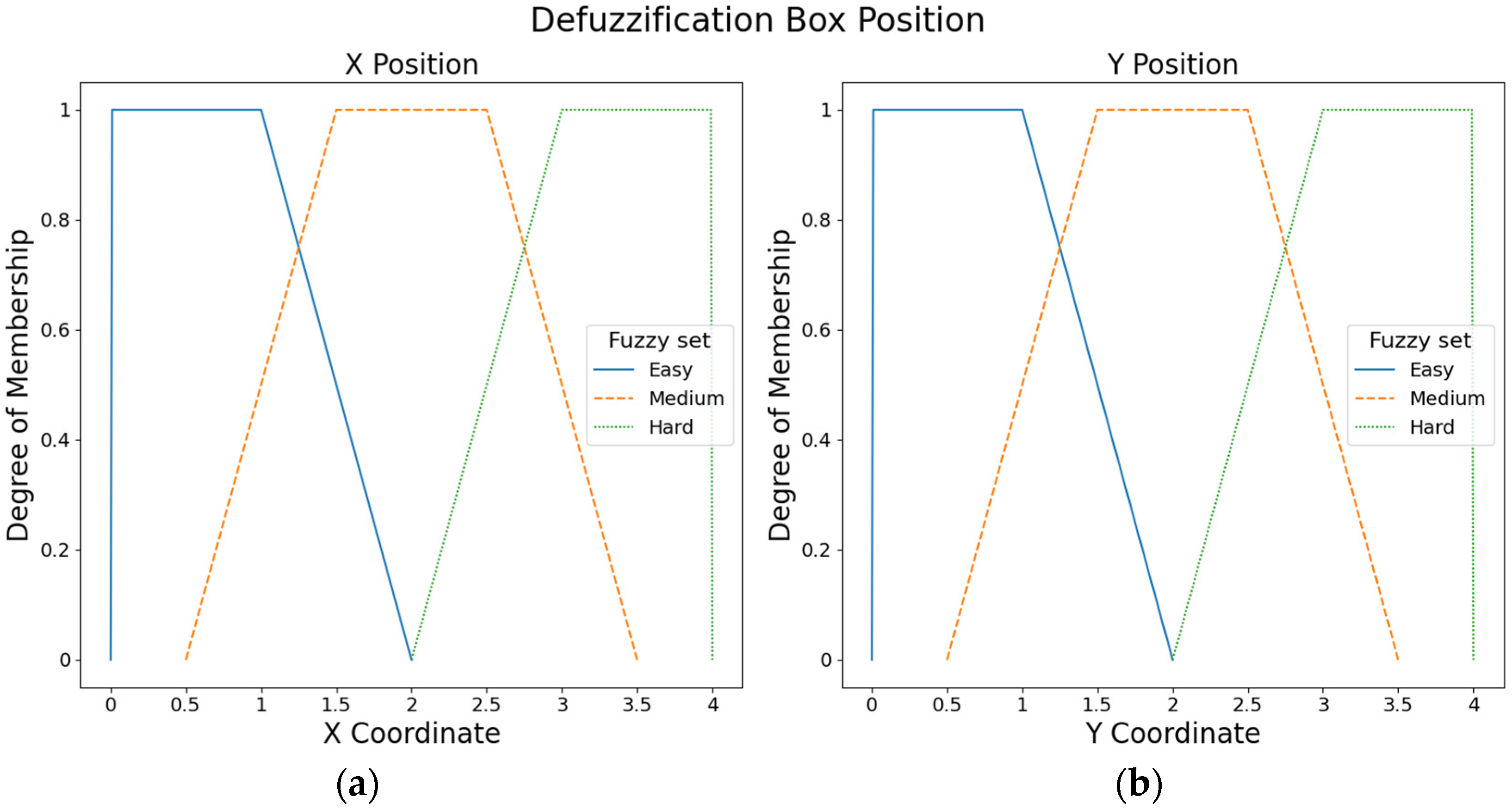
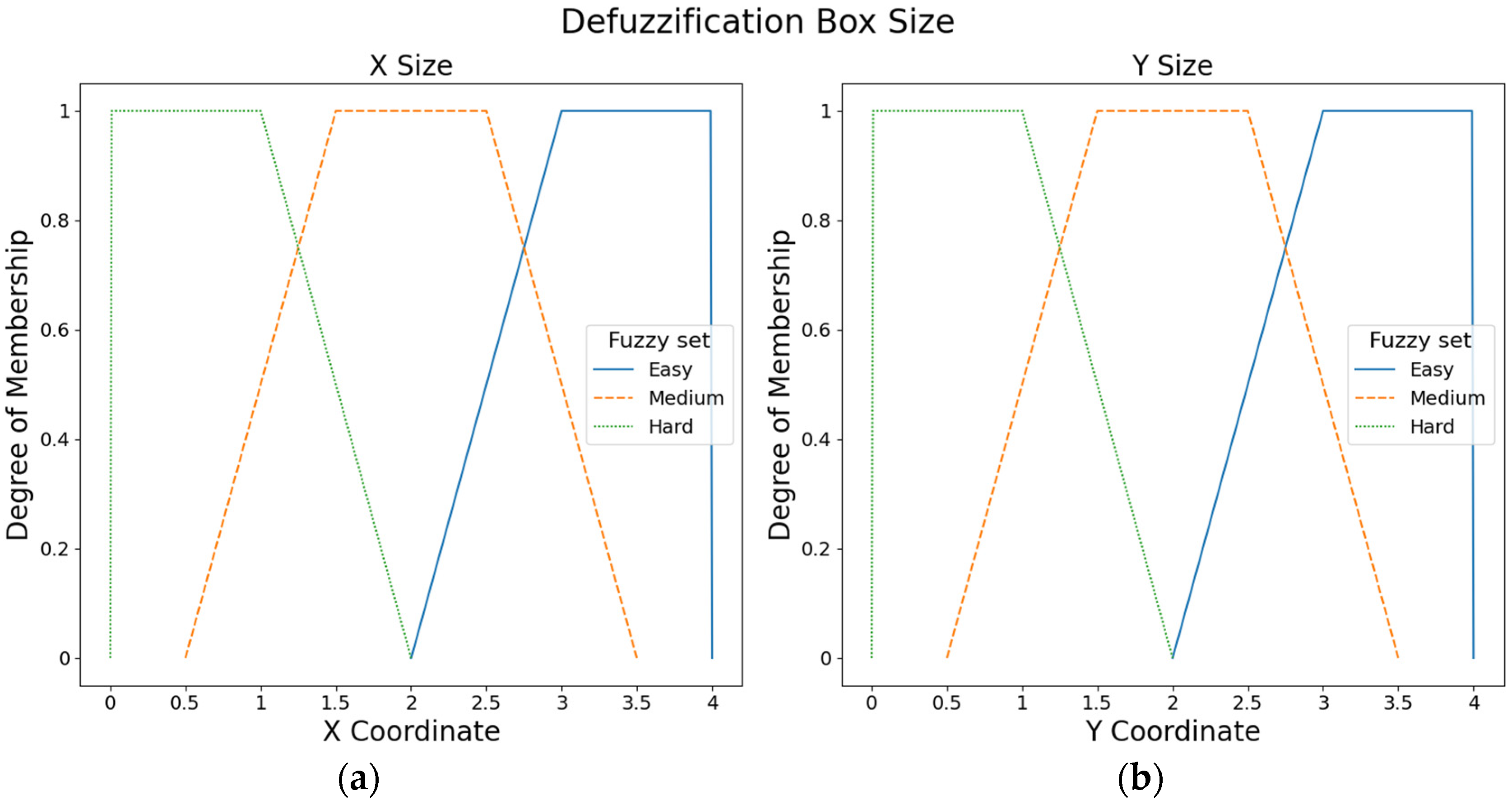


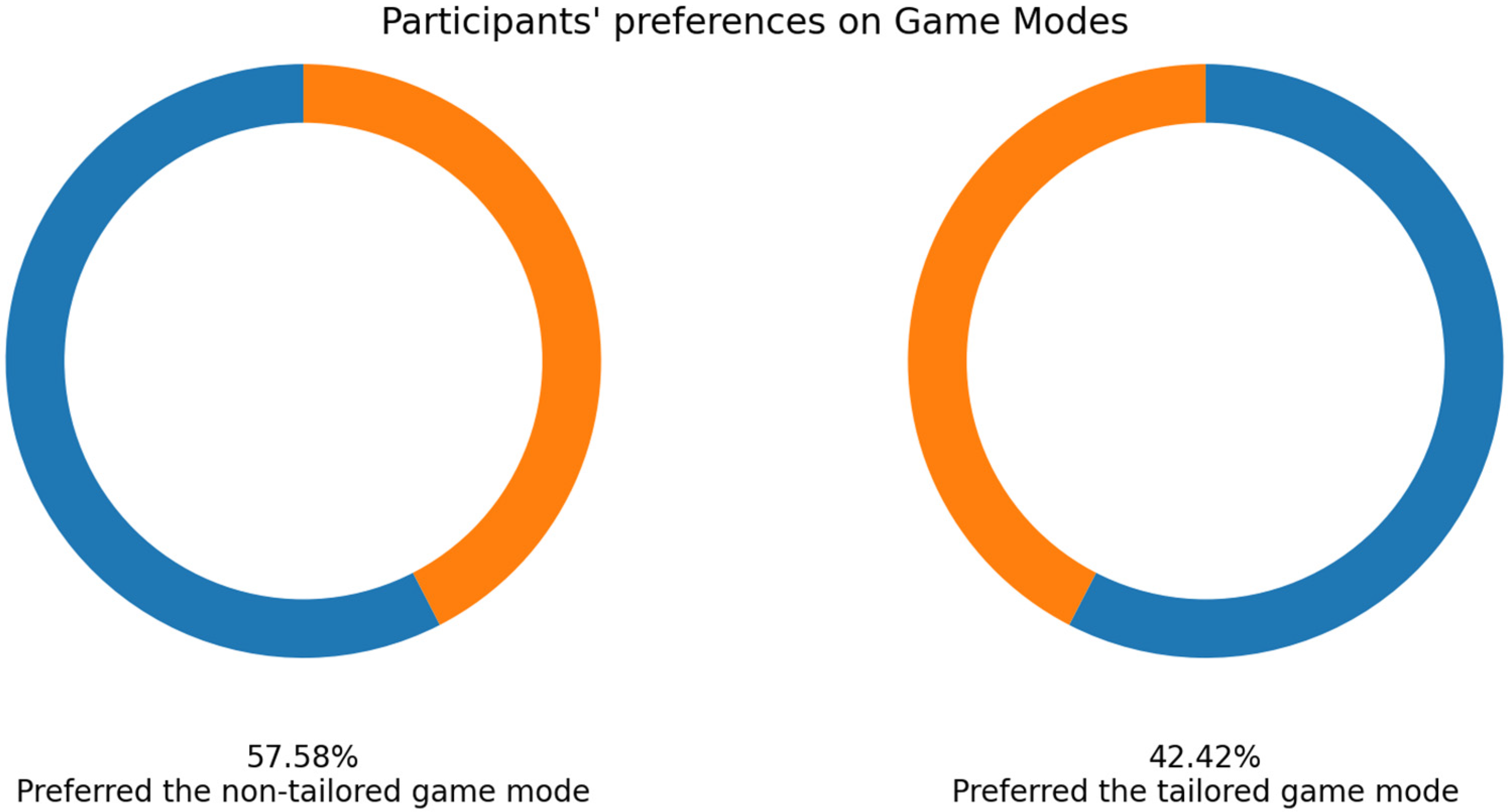
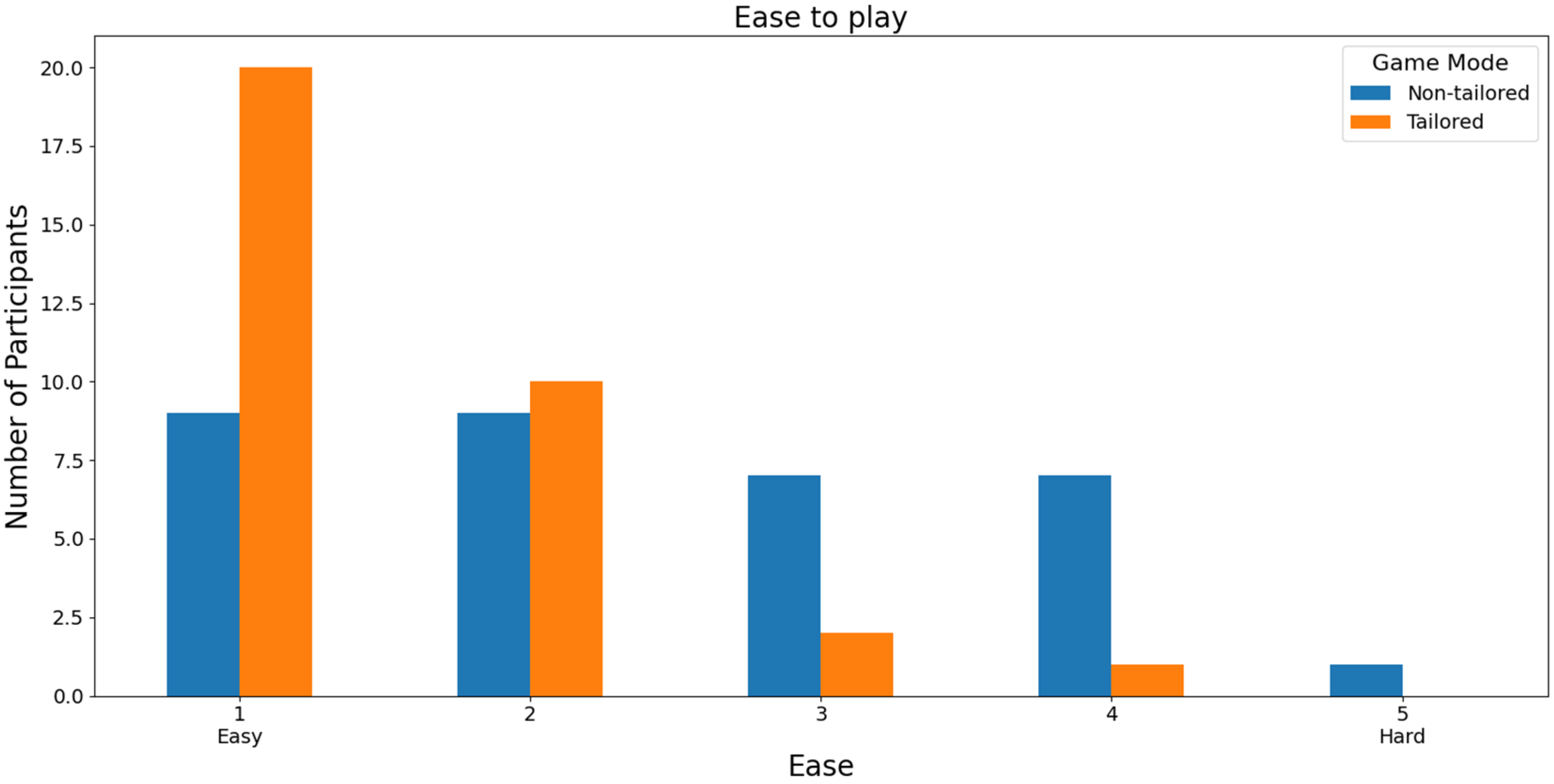




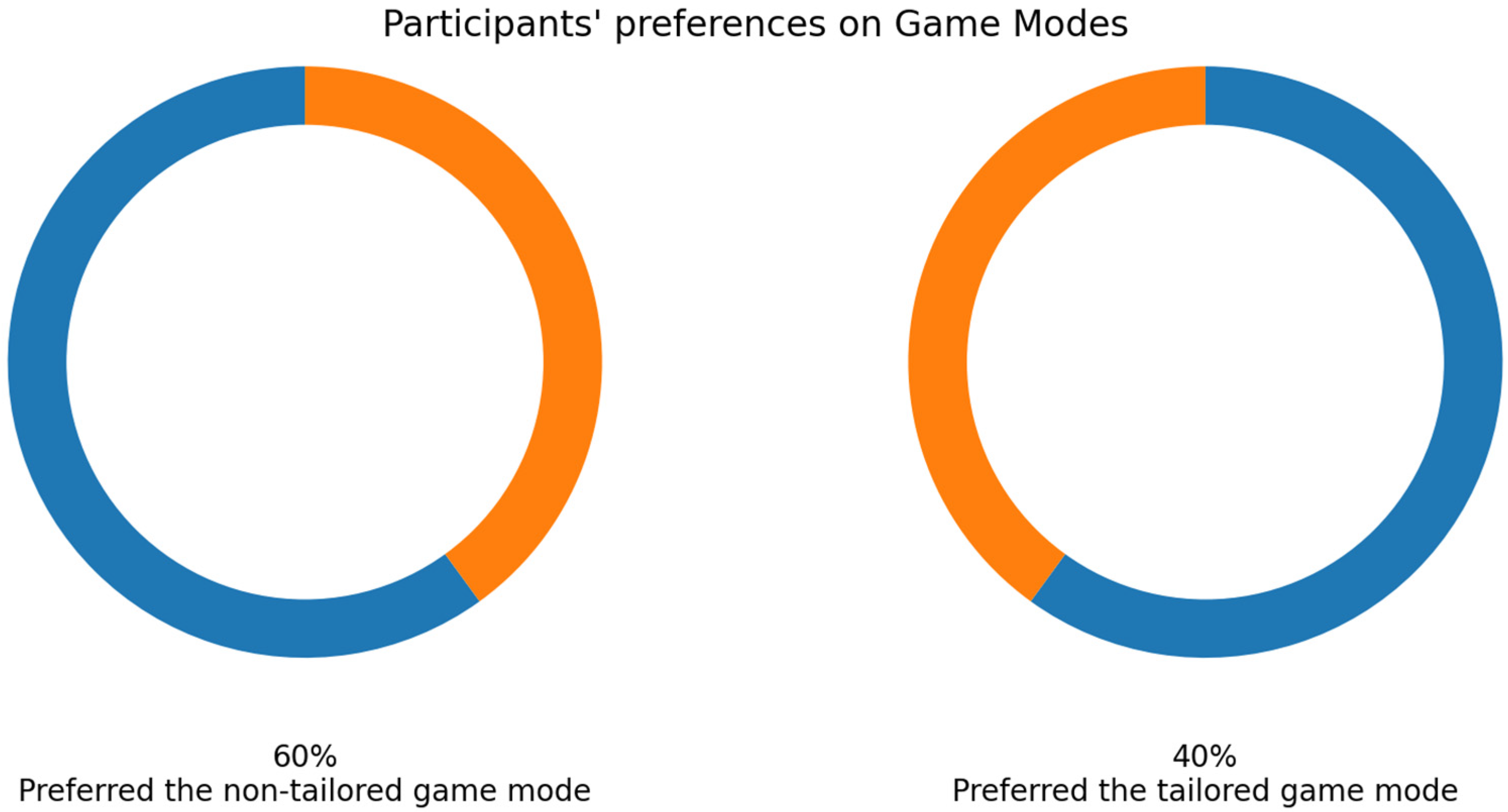
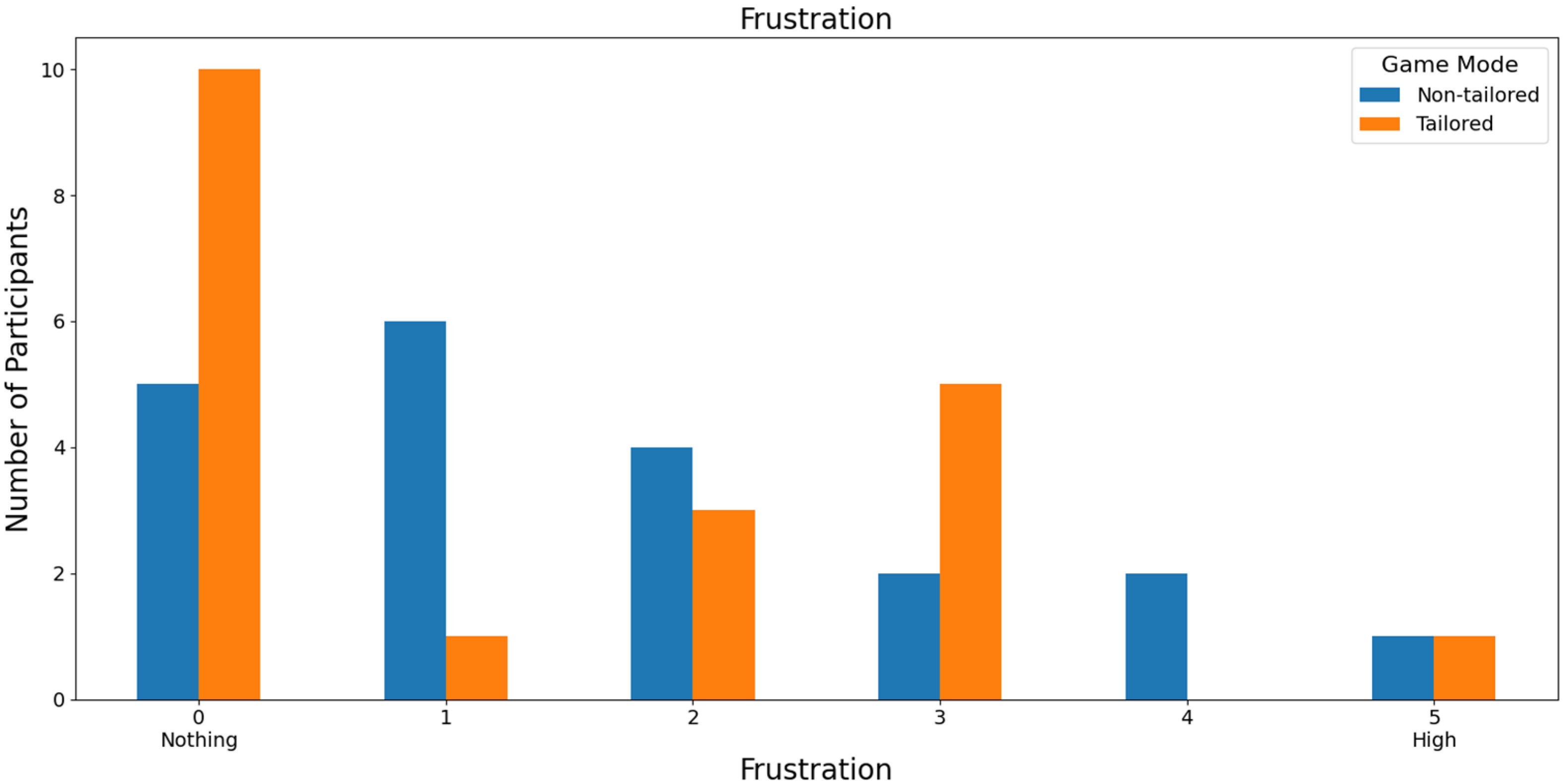

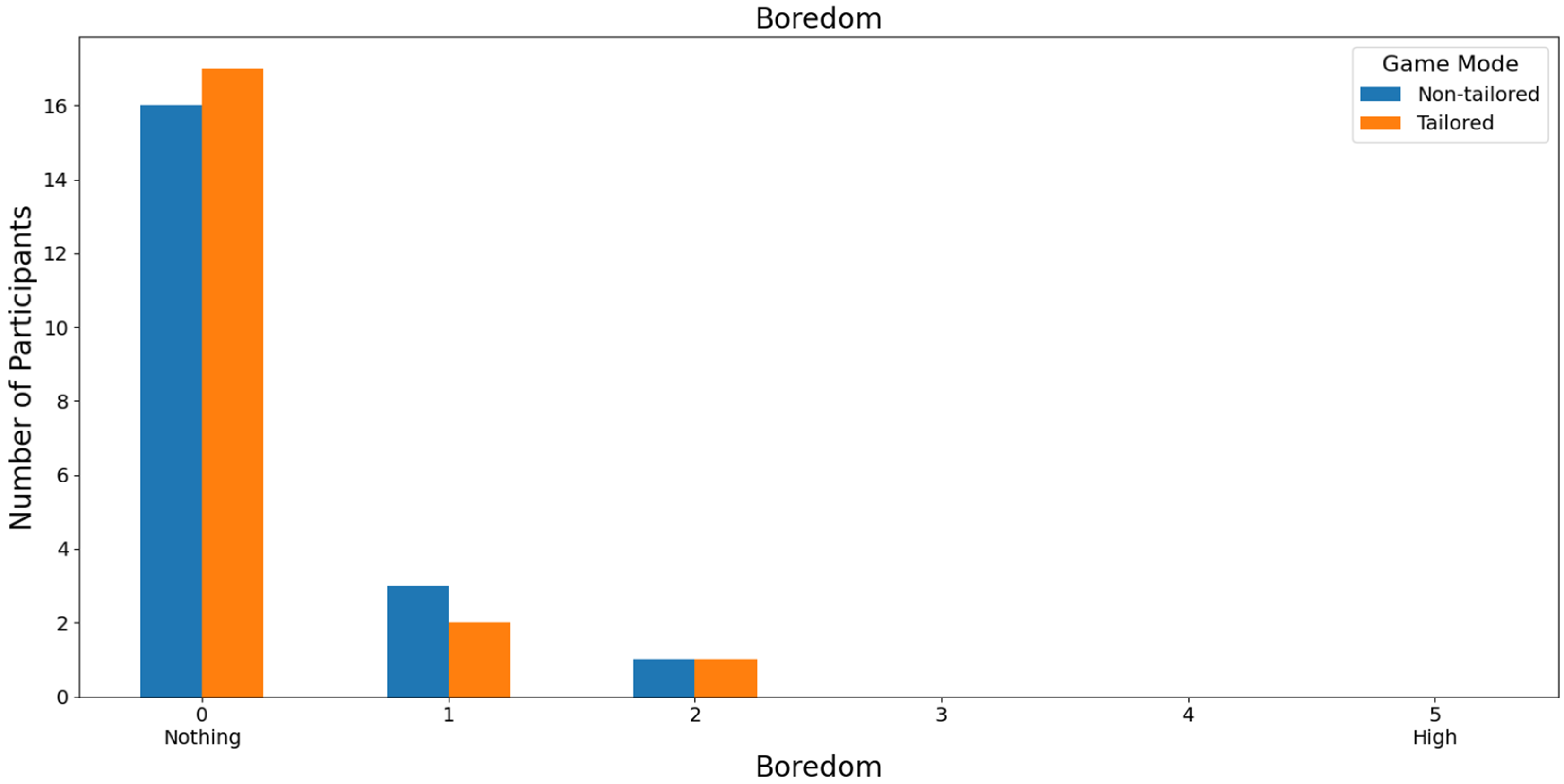
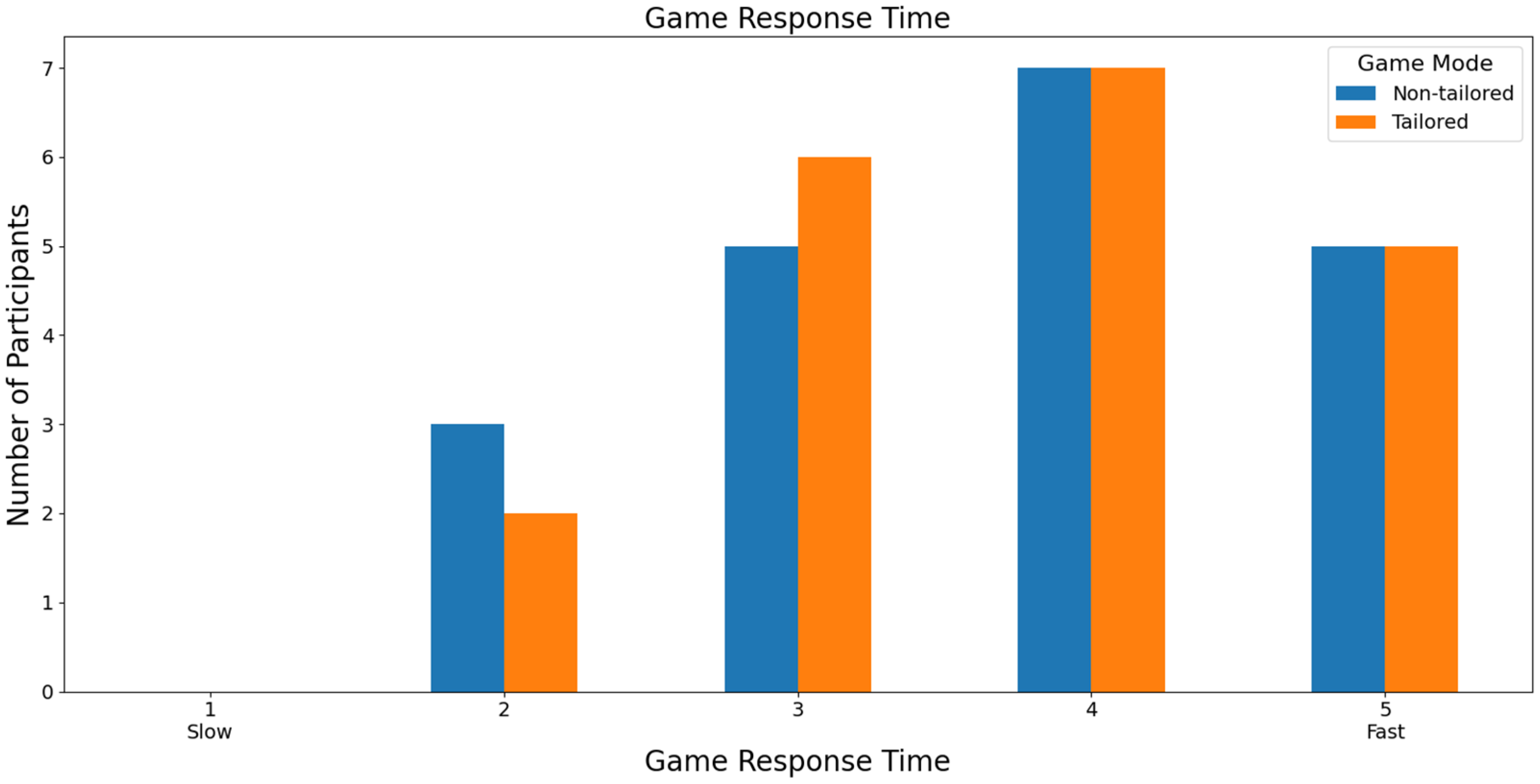
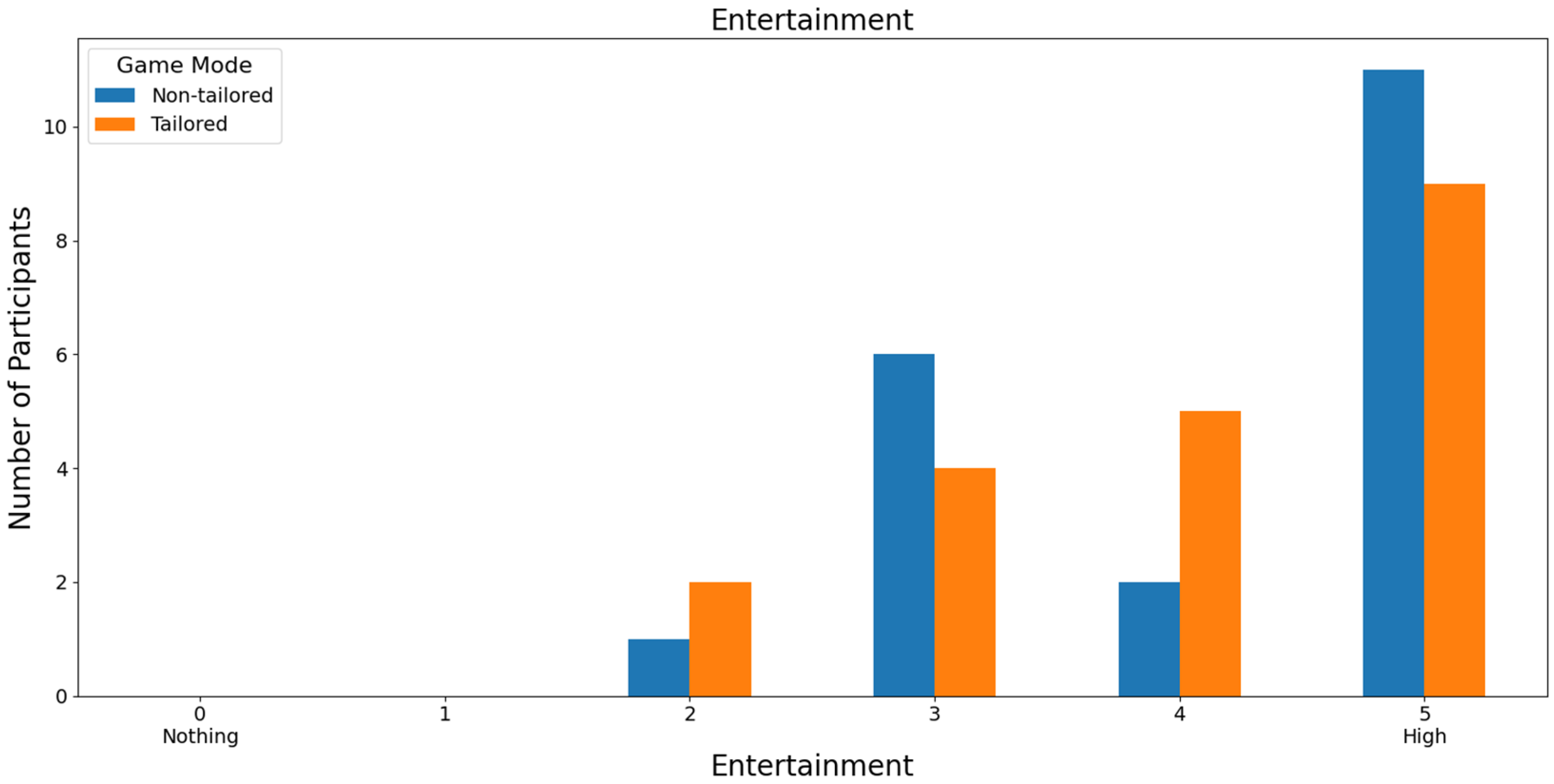
| Statistical Test | Association Between | |
|---|---|---|
| Chi-Squared Test | Favorite Mode (Non-Tailored, Tailored) | Sensor Used (Bitalino, Unicorn) |
| Fisher’s Exact Test | Game modes (Non-tailored, tailored) | Unicorn sensor—Ease of play: Likert scale values (1: easy; 2, 3, 4, and 5: hard) Considered Likert scale values for the test: (1, 2, 3, 4) |
| Fisher’s Exact Test | Game modes (Non-tailored, tailored) | Unicorn sensor—Frustration: Likert scale values (0: nothing; 1, 2, 3, 4, and 5: high) Considered Likert scale values for the test: (0, 1, 2, 3) |
| Fisher’s Exact Test | Game modes (Non-tailored, tailored) | Unicorn sensor—Boredom: Likert scale values (0: nothing; 1, 2, 3, 4, and 5: high) Considered Likert scale values for the test: (0, 1, 2, 3) |
| Fisher’s Exact Test | Game modes (Non-tailored, tailored) | Unicorn sensor—Game response time: Likert scale values (1: slow; 2, 3, 4, and 5: fast) Considered Likert scale values for the test: (2, 3, 4, 5) |
| Fisher’s Exact Test | Game modes (Non-tailored, tailored) | Unicorn sensor—Entertainment: Likert scale values (0: nothing; 1, 2, 3, 4, and 5: high) Considered Likert scale values for the test: (3, 4, 5) |
| Fisher’s Exact Test | Game modes (Non-tailored, tailored) | Bitalino sensor—Ease of play: Likert scale values (1: easy; 2, 3, 4, and 5: hard) Considered Likert scale values for the test: (1, 2, 3, 4) |
| Fisher’s Exact Test | Game modes (Non-tailored, tailored) | Bitalino sensor—Frustration: Likert scale values (0: nothing; 1, 2, 3, 4, and 5: high) Considered Likert scale values for the test: (0, 1, 2, 3, 5) |
| Fisher’s Exact Test | Game modes (Non-tailored, tailored) | Bitalino sensor—Boredom: Likert scale values (0: nothing; 1, 2, 3, 4, and 5: high) Considered Likert scale values for the test: (0, 1, 2) |
| Fisher’s Exact Test | Game modes (Non-tailored, tailored) | Bitalino sensor—Game response time: Likert scale values (1: slow; 2, 3, 4, and 5: fast) Considered Likert scale values for the test: (2, 3, 4, 5) |
| Fisher’s Exact Test | Game modes (Non-tailored, tailored) | Bitalino sensor—Entertainment: Likert scale values (0: nothing; 1, 2, 3, 4, and 5: high) Considered Likert scale values for the test: (2, 3, 4, 5) |
Disclaimer/Publisher’s Note: The statements, opinions and data contained in all publications are solely those of the individual author(s) and contributor(s) and not of MDPI and/or the editor(s). MDPI and/or the editor(s) disclaim responsibility for any injury to people or property resulting from any ideas, methods, instructions or products referred to in the content. |
© 2024 by the authors. Licensee MDPI, Basel, Switzerland. This article is an open access article distributed under the terms and conditions of the Creative Commons Attribution (CC BY) license (https://creativecommons.org/licenses/by/4.0/).
Share and Cite
García-Ramón, R.D.; Rechy-Ramirez, E.J.; Alonso-Valerdi, L.M.; Marin-Hernandez, A. Engagement Analysis Using Electroencephalography Signals in Games for Hand Rehabilitation with Dynamic and Random Difficulty Adjustments. Appl. Sci. 2024, 14, 8464. https://doi.org/10.3390/app14188464
García-Ramón RD, Rechy-Ramirez EJ, Alonso-Valerdi LM, Marin-Hernandez A. Engagement Analysis Using Electroencephalography Signals in Games for Hand Rehabilitation with Dynamic and Random Difficulty Adjustments. Applied Sciences. 2024; 14(18):8464. https://doi.org/10.3390/app14188464
Chicago/Turabian StyleGarcía-Ramón, Raúl Daniel, Ericka Janet Rechy-Ramirez, Luz María Alonso-Valerdi, and Antonio Marin-Hernandez. 2024. "Engagement Analysis Using Electroencephalography Signals in Games for Hand Rehabilitation with Dynamic and Random Difficulty Adjustments" Applied Sciences 14, no. 18: 8464. https://doi.org/10.3390/app14188464
APA StyleGarcía-Ramón, R. D., Rechy-Ramirez, E. J., Alonso-Valerdi, L. M., & Marin-Hernandez, A. (2024). Engagement Analysis Using Electroencephalography Signals in Games for Hand Rehabilitation with Dynamic and Random Difficulty Adjustments. Applied Sciences, 14(18), 8464. https://doi.org/10.3390/app14188464






